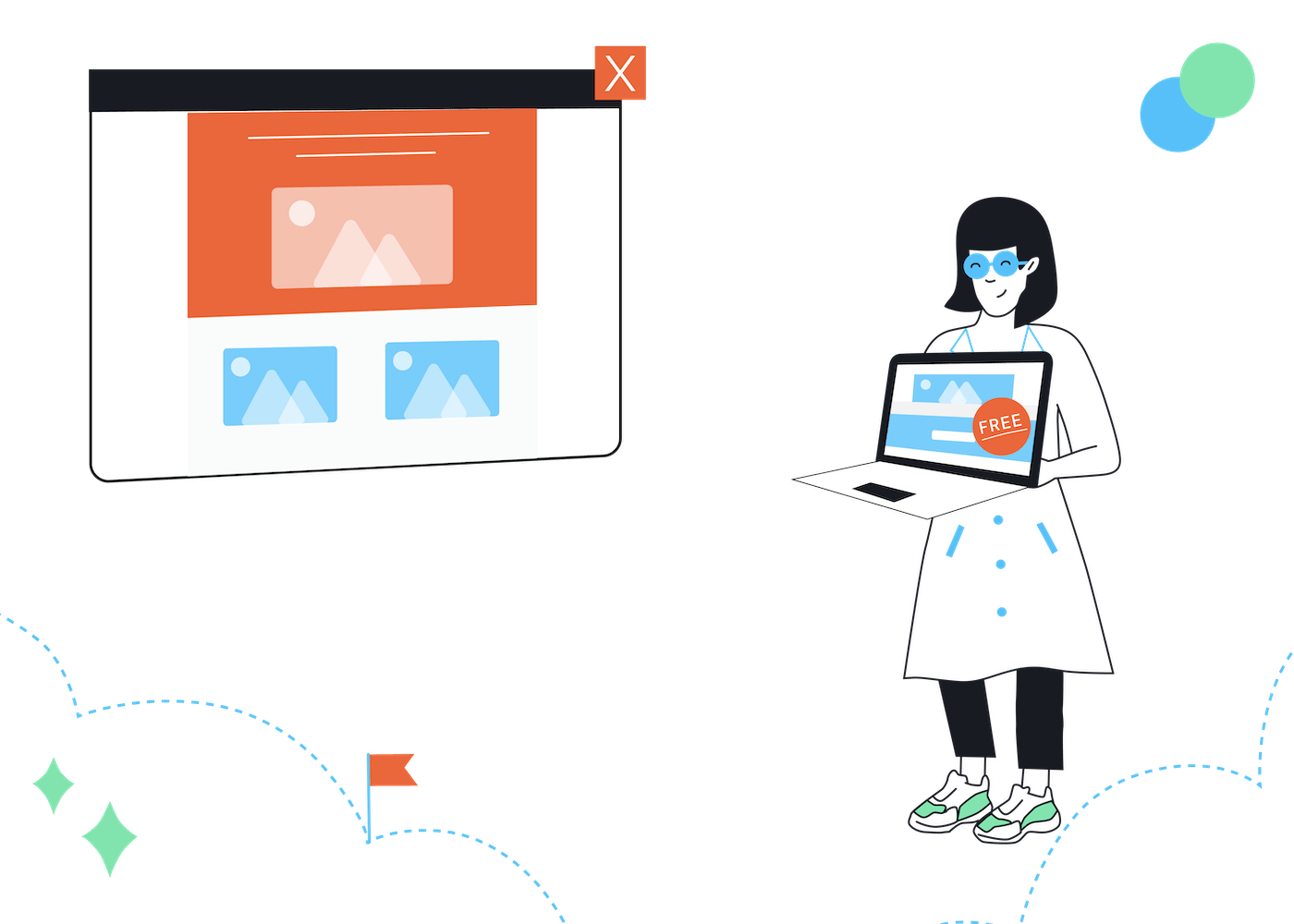Marketing automation is supposed to make our lives easier… so why is it so hard to come up with new automated email ideas? Using automated emails isn’t enough — you have to craft your emails to be engaging and alluring. And unlike for sending emails, there’s no automated software for writing them.
In this guide, we share 13 automated email examples to give you some good ideas. We’ll cover the most effective types of automated emails, with an example for each, and give some quick pointers on how you can use them yourself. But first, let’s take a deeper look at how email automation works.
What Is Email Automation?
Email automation is when emails are sent automatically from your account in response to certain “triggers,” such as a welcome email being sent automatically when someone joins your mailing list. They’re also called “trigger emails” or “behavior-driven emails” because of their prompts.
Although some email providers have rudimentary options for automation (such as single-email autoresponders), email marketing automation is a little more complicated because it relies on precision and more specific triggers. For example, you can set an automated email response if your user leaves an abandoned cart, visits a specific page on your website, or has a birthday coming up.
See email automation in action in our quick explainer video:
Email automation not only saves you time and keeps you on the ball with emails — it also does wonders for encouraging customer loyalty and building your brand. By choosing the right triggers, you can make sure customers see your emails at the right time — and you don’t have to do anything after the initial setup.
Essentially, you can tailor your email automation campaigns to target your business’s weak points, such as increasing sales for a certain product or re-engaging your users if they lose interest over time. You can also pinpoint and guide your customers through different points of the email funnel.
How to Set Up Email Automation for Marketing
When you get into advanced email automation campaigns, it’s best to use marketing automation software. These have more options for automation than most email providers, which allows you to fine-tune your campaigns around your unique goals. Take a look at our comparison guide for email automation software to see which one seems right for you.
Email marketing platforms like MailChimp or ActiveCampaign have autoresponders and other automation tools that allow you set your own triggers with boilerplate responses. What triggers you use, and what kinds of emails you send after them, is the real challenge.
So to help you understand what automated email marketing campaigns work best, below we look at 13 automated email examples, with some tips on how to use them yourself.
13 Automated Email Examples
1. Welcome emails

You can set email automation to send a welcome email every time a new user signs up. This is a friendly way to welcome people into your community and get them excited about joining.
Welcome emails should serve two main purposes:
- validating the choice to sign up by reminding them about the benefits
- giving them a clear idea of what they can do next with call-to-action (CTA) suggestions
The automated email example from Girlboss handles both of these objectives well. Their email opens with a paragraph that subtly mentions they have over 250,000 users, validating the reader’s choice to join (because hundreds of thousands of people can’t be wrong).
It then continues to describe the current topics they discuss — a benefit or feature of the newsletter — and reminds them about the free coffee.
The rest of the welcome email contains multiple links to both articles and products. This gives the reader direct options for what to do next, so that they can pick the next step that works best for them.
Often, new signups aren’t sure what to do or where to go. Providing CTAs with direct links not only benefits you with more traffic or sales, it also benefits them as a way to guide or recommend how they can proceed and make the most out of your service.
2. Lead magnet sign-up
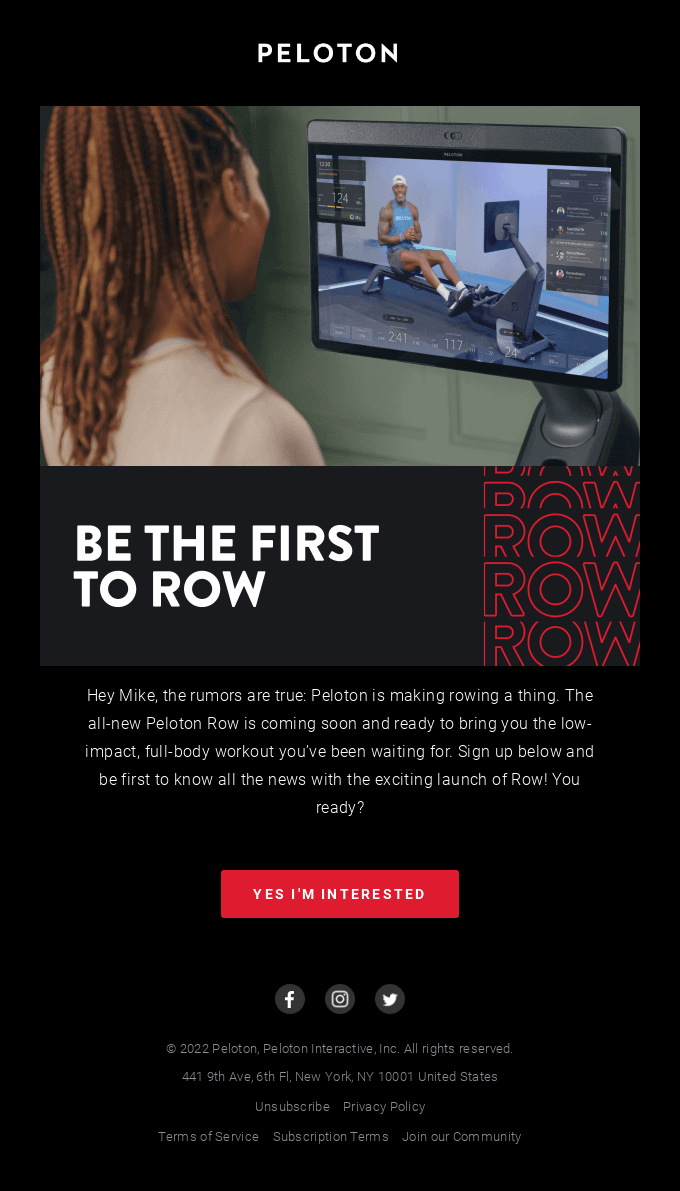
Lead magnets are incentives used to collect emails or other contact information of people who may be interested in a particular product or service – and ultimately, generate more leads. While your newsletter may be a lead magnet itself to collect email addresses, you can also send additional lead-magnet emails to get more specific kinds of customers to certain products or services.
Typically, online lead magnets consist of ebooks, webinars, courses, or other free gifts used for raising brand awareness. However, brand magnets can also be used strategically to sell specific products, especially in emails like Peloton’s that showcase a certain type of product to see who’s interested.
Structure lead magnet emails like an ad promoting whatever your lead magnet is, whether that’s a free ebook or a paid feature. Following advertising conventions, you want to mention a problem the reader might have, and offer a solution. (See more lead magnet ideas and tips on how to write lead magnet emails.)
Just like an online ad, you want to include a single, visually attractive CTA button that catches attention. The CTA should lead to wherever your reader can give their contact information. Unlike a newsletter or welcome email, be sure to only include one CTA so your reader doesn’t get distracted.
3. Seasonal/holiday offers
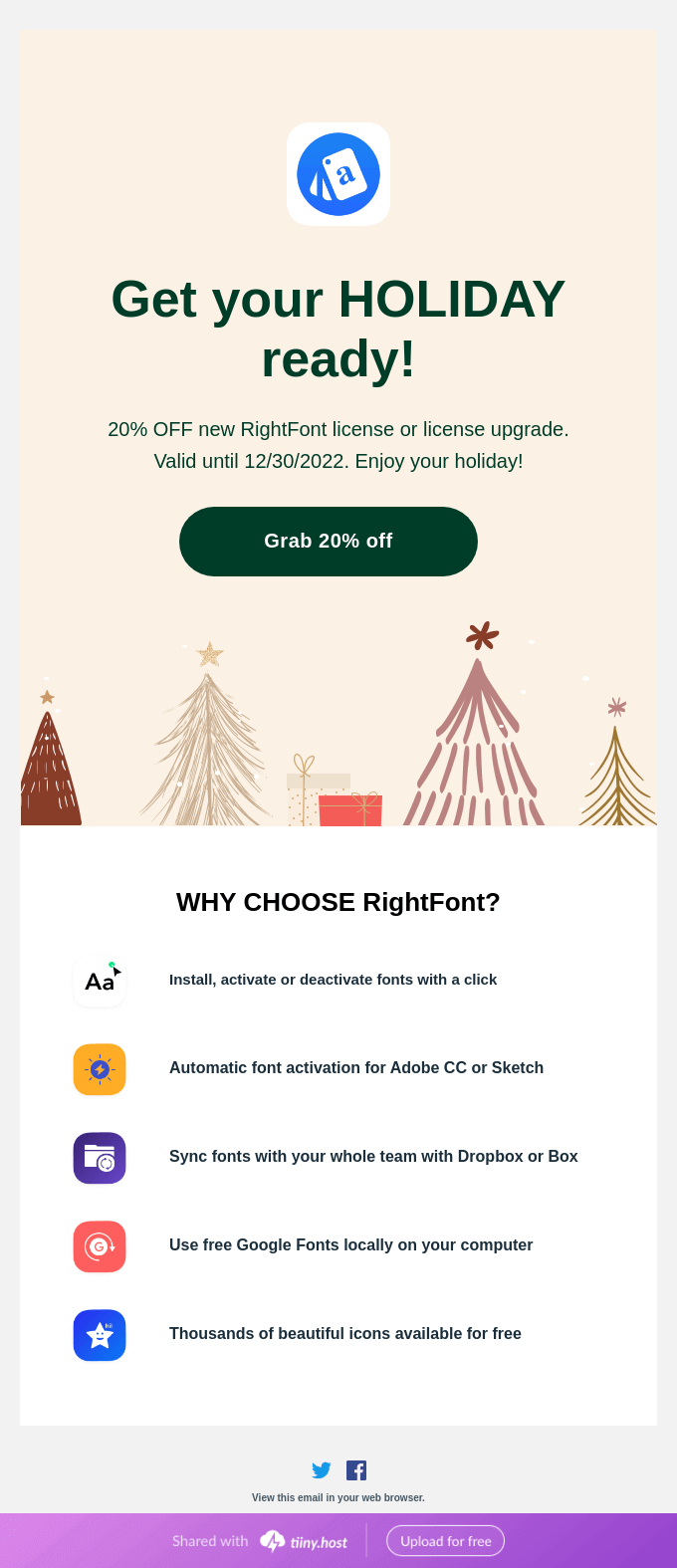
Seasonal and holiday emails are a way to tap into the “holiday spirit.” People tend to be more excited during the holidays, and therefore more receptive to offers. It’s also a common time to offer deals and promotions, which will only make your readers more cheerful.
You can use automation to schedule your holiday emails ahead of time, and to build up the buzz around an upcoming holiday offer over a series of emails. You can also include some “last chance” emails towards the end of the campaign.
Holiday emails should be happy and uplifting to match the mood of your reader. Bright colors and celebratory images work well, especially with the theme of the holiday or season you’re writing about (e.g., using cartoons of Santa for Christmas or falling leaves for autumn).
As with RightFont’s holiday email, yours should also focus on a specific promotional offer — ‘tis the season for great deals! Put the benefits of your deal front and center so the reader can see them first, and again only use a single CTA button, designed to attract attention.
4. Birthdays

If your subscribers add their birthday during your signup process, you can use email automation to automatically send them a birthday email on the right day. This can also be easily tweaked for any milestone event, such as anniversaries or scheduled events, depending on your industry.
Birthday emails are about letting your subscribers know you care. For customer appreciation, deals and gifts work much better than just best wishes, although if you’re under a tight budget simply wishing someone a happy birthday is better than nothing.
Like seasonal and holiday emails, birthday emails should also be cheerful with a happy atmosphere. Visual imagery should focus on themes like birthday cakes, candles, and presents. As you can see from the Dutch Bros automated email example, they put the offer at the top and decorate the main photo with cute birthday candle illustrations.
5. Product launch

If you’re offering a brand new product, who better to notify than your already loyal customers. Product launch emails are perfect for advertising and building a buzz around something new, even before it’s actually available. They can be automated to go out to subscribers who have previously shown an interest in certain products, or in hearing about new products. You can even create entire drip campaigns around product launches, using multiple emails to progressively build interest in your products.
Product launch emails should be designed like highly stylized product pages. Everything should promote the product, just like a product page, with flashy, high-quality images and lists of features. You can also add a text description, too, in the same style as product pages, too
Leave it to Apple to show you how to promote a product. Their automated email example for the AirPods Pro launch demonstrates all the key points you, too, should hit. The entire email looks gorgeous, with mesmerizing photos and eye-catching typography.
All the benefits of the new product are laid out in an easy-to-follow format. Notice how each feature gets its own separate area of the email, with its own picture and a brief text description. This makes it easier for the reader to scan and find the features relevant to them.
6. Email courses
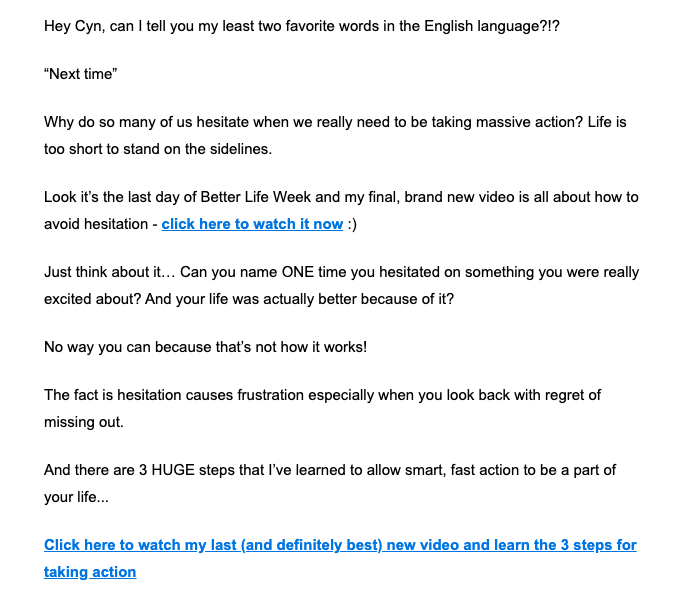
In the spirit of automated emails for lead magnets, you can also set email automation to send regular lessons: courses, webinars, video lessons, and other educational materials. Such content, when about a topic you specialize in, can effectively function as a lead magnet or even as a salable commodity itself (for example, a paid newsletter).
Course emails tend to be text-based because they’re thick with information. The text itself is often conversational like a teacher’s lecture, with language that directly addresses the reader, like the Better Life Week automated email example. Huge blocks of text in an email tend to scare people, so it’s best to break them into small paragraphs and in some cases use emoji.
However, a lot of people prefer learning by video. Rather than embedding long videos in email, you can link to a page where the full video is hosted. In this case, you want your CTA (or multiple CTAs) to link only to this page. Moreover, it’s also best to dedicate the entire landing page just to your videos, so your visitor doesn’t have to search for them on a busy page.
7. User onboarding
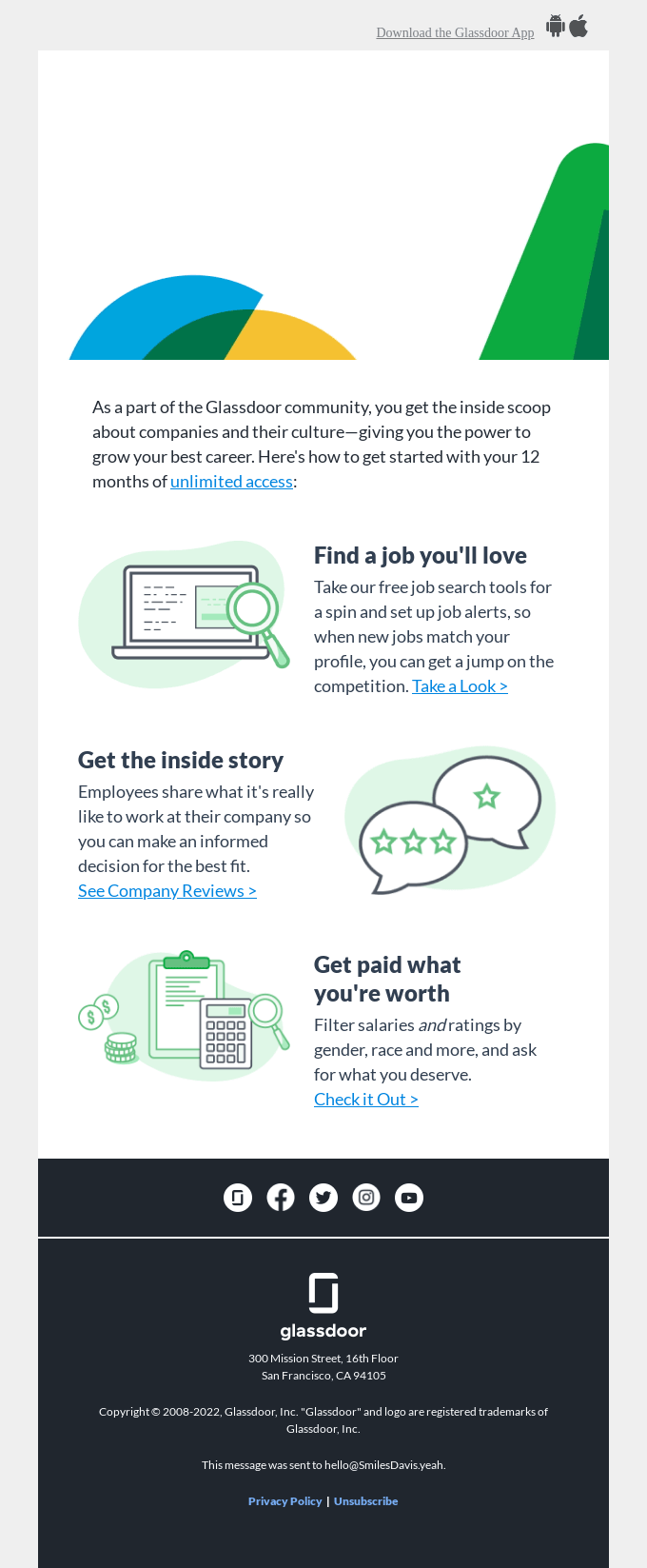
Email automation can also improve user onboarding, the process of learning how to use your app, site, software, goods, or services. You can set automated emails for onboarding at a certain amount of time after new users sign up, to give them a little bit to explore on their own or figure it out themselves.
Emails like this can help answer users’ questions before they have to ask, or teach them certain features they wouldn’t discover on their own, which is especially useful if you have a product with a steep learning curve. They are particularly useful in industries like SaaS, as you can see in these SaaS email marketing examples.
Onboarding emails should have multiple tips, instructions, or links since you don’t know for sure what problems your user is having. Giving them a few paths to choose from lets them go straight to what they need help with. As different people will have different issues, you want to present a variety. User testing can help identify common problems new users tend to have.
As with Glassdoor’s automated email example, you can promote different features and functions to introduce users to new benefits. Each of the CTAs in Glassdoor’s email solves a different problem and caters to a different type of user.
Tagging contacts when they click on a specific link can also help you to create more meaningful segments, and to send them content that’s more targeted to their needs.
8. Abandoned cart

Abandoned cart emails are a popular trend in ecommerce already, and for good reason. Online shoppers abandoning their carts is quite common, but often you can turn those would-be purchases into actual sales just by sending a small, polite reminder. Most email marketing services offer this trigger built-in because it’s a staple for online retailers.
As you can imagine, your abandoned cart emails should “stoke the flames” and remind the shopper why they loved the abandoned items in the first place. The easiest way to do this is to feature a product photo of the item, or at least list them, to jog the shopper’s memory.
Less obvious, you can also include similar products to the ones in the abandoned cart, as in the Perigold example. Sometimes a shopper abandons their cart on purpose because it’s not quite what they want. Offering a shopper similar options might help them hone in on what they truly want, or offer something comparable at a better price.
9. Cross-selling and recommended products

Automated emails for cross-selling and recommended products are like hand-picked suggestions once you know your customer’s tastes. They can be triggered at a set amount of time after a sale with products related to the original purchase — since you already know that’s the kind of thing they like.
Similar to upsells before a sale, cross-selling and recommended product emails leverage what you know about the customer, specifically part of their tastes. A lot of people enjoy recommendations of products they didn’t know about, but only if they’re personalized individually for them.
These emails work best when you stick to products specifically related to the first purchase — this is not the place for advertising random products or to try to unload poor-performing products. These emails are about personalization, so promoting unrelated products will just seem like a spam email.
Like the Goodreads example, you want to open the email with a reminder of the original purchase. This is a good place to elicit a user review if you enable ratings on your site. From there, you can offer multiple “related products.” It’s always a good idea to feature a few different options, since it’s difficult to pinpoint what part exactly they enjoyed about the original purchase.
10. Customer rewards
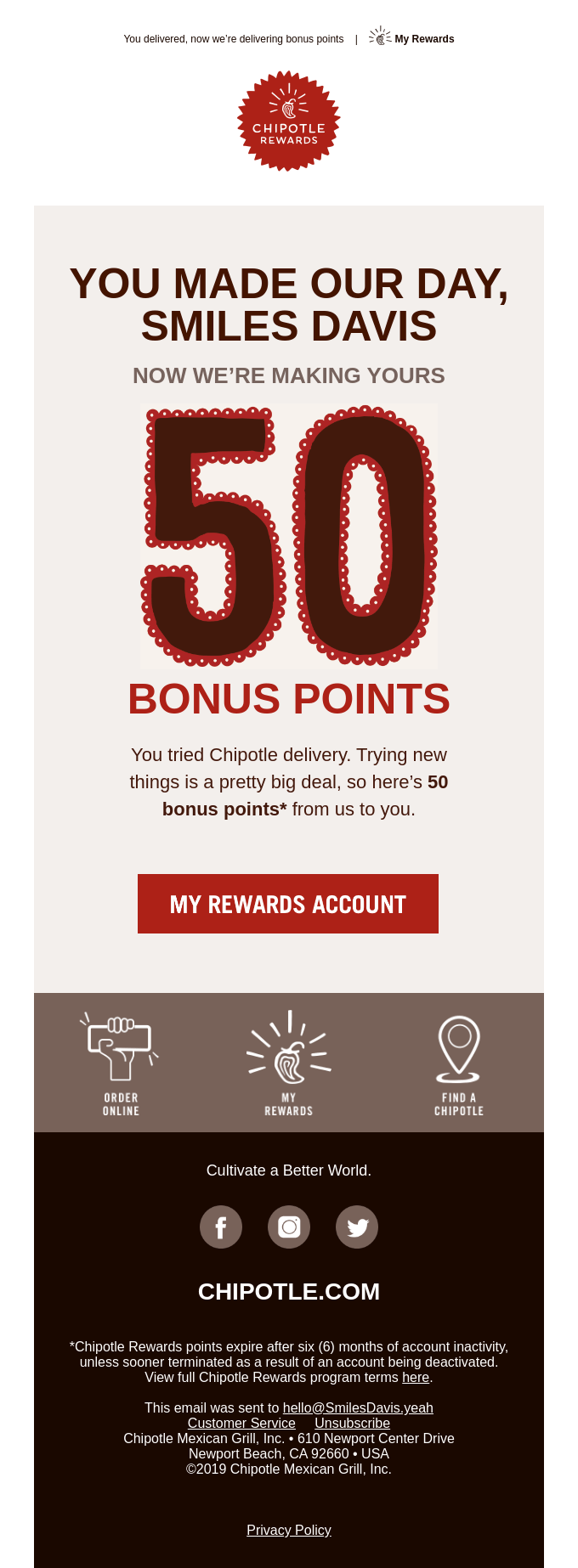
Loyalty programs are always a smart strategy for building customer loyalty — after all it’s in the name! Setting automated emails to deliver the good news every time the customer qualifies (for example, after a certain amount of purchases) not only saves you time, but also gets your customers more enthusiastic about you, forging a stronger relationship with your brand.
In the spirit of gift-giving, the tone of these emails should be fun, happy, and positive, with bright colors and cute imagery. In the Chipotle example, you can see the festive decoration on the number fifty.
To further the themes of loyalty, show your gratitude for your customer’s patronage. You can say a simple thank you, or give a compliment like Chipotle’s “you made our day.” It also helps to provide a direct link to the page where they can manage their rewards.
11. Referrals

Another great strategy for building customer loyalty is referral programs. Peer-to-peer word of mouth is some of the best advertising, but you can take it even further by offering incentives for customers to bring in new customers. Referrals are extra effective if you extend the benefit to the new customer as well.
Emails promoting your referrals program can be scheduled a certain amount of time after a new signup or first-time purchase. If the user hasn’t spent much time on your site or app, they may not know about your referral program, so treat this email like a promotional notification.
These emails should be positive and lighthearted; above all, they should put the benefit first. The reader is going to want to know what they get out of the referral, so make that clear right from the start.
12. Customer feedback

If you’re having a persistent problem with customers, such as constant cancellations, you can reveal the root of the problem by getting customer feedback. These automated emails can be set to trigger when a customer performs a certain action, such as canceling their account.
The trick with feedback emails is to allow your readers to provide feedback directly in the email. Interactive rating systems embedded directly in the email work best; each extra step or new page the user has to visit decreases their chance of a conversion. The more streamlined your feedback process is, the more responses you’ll get.
If you must send the reader to another page, such as a survey, build your email around a single and clear CTA. It’s best to mention the benefits first, such as a free gift for participating.
13. Re-engagement
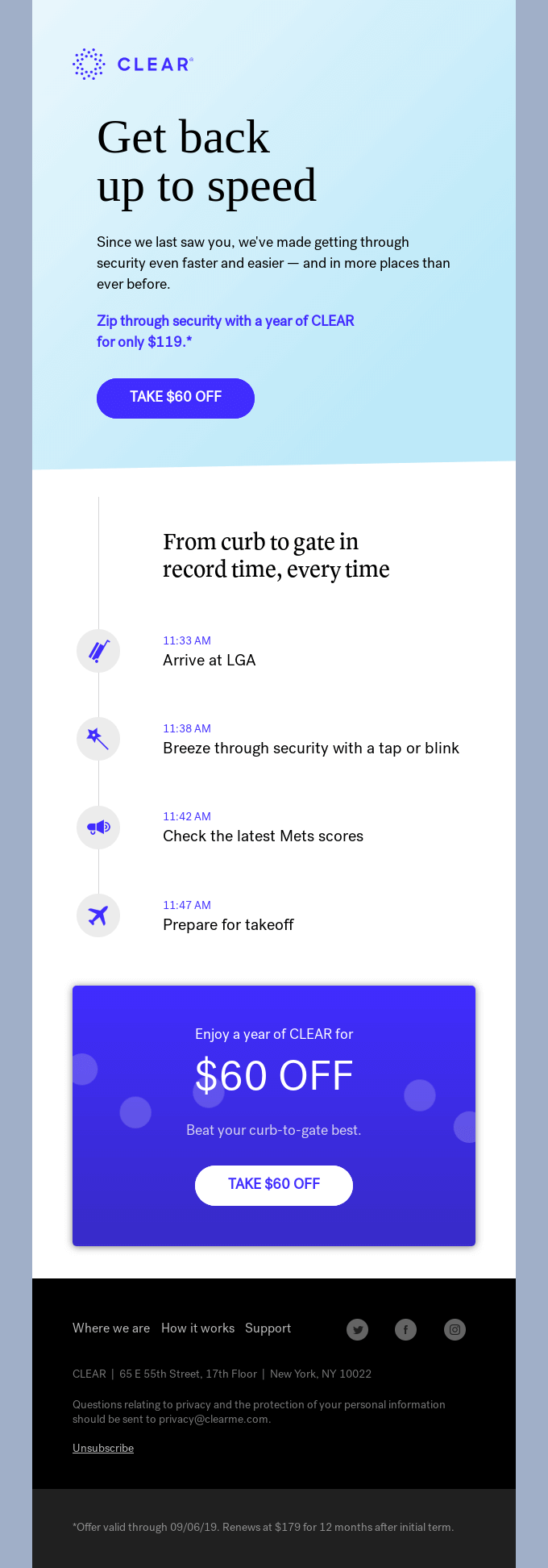
Re-engagement emails are a way to gently nudge your users and customers to visit or use your product more. They can be triggered after a certain amount of time is spent inactive — just be sure not to jump the gun too soon.
Re-engagement emails are about one thing and one thing only: incentivizing. You must give your reader a reason to engage more, whether a discount, new feature, or a reminder of why they joined in the first place. Without the incentive, they’ll likely just ignore the email and ultimately continue ignoring you.
Just like in other automated emails, make the new benefit the central focus. State the incentive right away and draw attention to it visually. In the CLEAR example, they put the feature in a different, brighter font to make it stand out, and give the CTA button the same treatment.
Avoid talking about why they haven’t been visiting; it may come across as nagging. If you do mention it, be understanding and don’t make it sound like they did anything wrong.
Think of re-engagement emails as a kind of last chance for keeping subscribers on your list. If after some time they still don’t re-engage, it’s a good opportunity to clean them off your list.
Conclusion
Email automation makes sure the right emails reach your readers at the right time, and at this they excel far better than a human sending them out manually. However, the real value of automation is for the sender, even more than the receiver. Once you create the emails and set the proper triggers, your job is done! That frees you up to handle more important tasks that are too complicated to be automated.
So the question isn’t whether or not to use automation — you definitely should — the question is how to use it. The automated email examples above should give you some inspiration and ideas about how you can fit email automation into your business strategy. Review the examples above and see which ones could help your business — and which ones would appeal most to your type of customer.
> Check out our top-rated email automation tools
Have any questions about implementing email automation in your business? Let me know in the comments below.
We keep our content up to date
14 Jul 2023 - Added automation explainer video
Our Methodology
This article has been written and researched following our EmailTooltester methodology.
Our Methodology